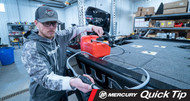Priming Your Outboard Fuel System
Today’s outboards are modern marvels, borne of precision engineering and generations of innovation. They’re quiet, dependable and efficient, and they’re purpose-built to help people enjoy hassle-free days on the water for years.
They do have a common bond with the first outboard ever built, or any other internal combustion engine, for that matter: They must have fuel to start and run. In this Mercury Quick Tip Video, the team at Wired2Fish shows you how to prime your fuel system – that is, to purge the air from the fuel line – so it will start right up when you turn the key or pull the rope.

Mercury FourStroke outboards 60hp and below are equipped with a primer bulb, a rubber spheroid the approximate size and shape of a chicken egg, located in the fuel line between the fuel tank and the engine. First, connect the fuel line to the engine, if not already attached, then pump (squeeze) the bulb repeatedly until it’s firm. It usually only takes a few pumps. When the bulb is firm, the line is charged and you can start the engine.
If your Mercury FourStroke outboard is 75hp or greater, the onboard electric fuel pump will prime the fuel system for you. Simply turn the key to the “run” position and wait. You’ll hear a beep, followed by the sound of the fuel pump running. In just a few seconds the pump will clear the air out of the fuel line, and you’ll be ready to start it up.
Click below to watch the video:
mercurymarine.com/en/us/dockline/quick-tip-priming-your-fuel-system/
Posted by Mercury Marine


